-
Engine5.0L V8
-
Power420 HP / 390 LB-FT
-
Transmission6-Speed Auto
-
0-60 Time4.3 Seconds (est.)
-
Top Speed145 MPH (est.)
-
DrivetrainRear-Wheel Drive
-
Curb Weight3,600 LBS (est.)
-
Seating2+2
-
MPG17 City / 26 HWY
Blink your eyes and take another look. While all visual cues may be telling your brain that you are staring at a near-pristine 1969 Ford Mustang Mach 1 Fastback, it's all a carefully crafted illusion – a very clever façade.
Hidden beneath that glistening Yellow Blaze paint, below the sculpted fiberglass and steel body panels, is a 2013 Ford Mustang GT. The retro-coupe features power-operated sport buckets with lumbar support, ice-cold air conditioning, six airbags and a full factory warranty. Lest anyone forget, it also comes with a modern fuel-injected 5.0-liter V8 generating 420 horsepower.
The team at Retrobuilt, out of Lamar, Missouri, is known for recreating Carroll Shelby's iconic cars of yesteryear. Yet instead of restoring worn classics to like-new condition, a process that delivers an immaculate muscle car yet retains all of its undesirable traits, they fabricate classics on current-generation Ford S197-platforms. In their own words, they "allow auto enthusiasts to benefit from the technology and manufacturing of a modern Ford Mustang while combining the classic styling of 1969 muscle cars."
Retrobuilt recently invited us to drive its 1969 Fastback mere days after its debut at the 2012 Specialty Equipment Market Association's trade show (SEMA) in Las Vegas. To make things a bit more interesting, and gauge public opinion, we chose to meet them at the entrance to Southern California's famed Mulholland Highway.
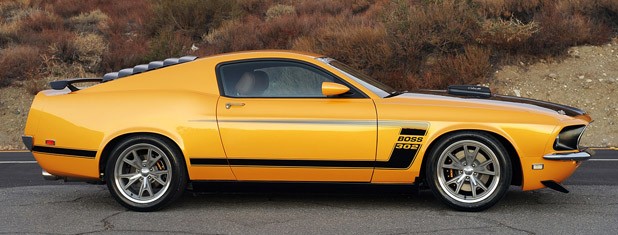
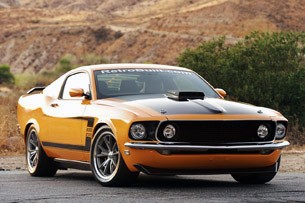
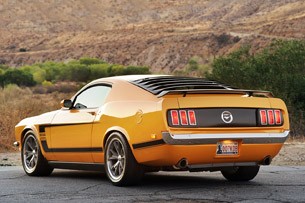
It doesn't take a rocket scientist to understand why this company is selling cars as quickly as they can make them. Old muscle cars are undoubtedly cool, but they are also temperamental, thirsty and uncomfortable when the weather isn't cooperating. The team at Retrobuilt, passionate about the classics but tired of the inconveniences, decided to marry the best of both worlds – thus its 197-based program was launched in 2009.
Retrobuilt works with Ford's S197 chassis, meaning candidates come from the current fifth-generation Mustang platform (2005-present). While some conversion companies purchase bodies-in-white from automakers, Retrobuilt relies on used cars (including those cosmetically damaged in hailstorms or tornados) or brand-new showroom stock vehicles. This particular build started as a brand-new 2013 Ford Mustang GT with a 5.0-liter V8, but it could have just as easily been a 2005 Mustang Coupe with a 4.0-liter V6, or a 2013 Shelby GT500 boasting a supercharged 5.8-liter V8. It is, ultimately, the customer's choice. (The company prefers to start with a vehicle painted black, as the dark sheetmetal under the hood is color correct for the era.)Old muscle cars are undoubtedly cool, but they are also temperamental, thirsty and uncomfortable.
Before the rebuild process begins, the steel hood and front quarter panels are removed from the donor. It is much the same story with the front and rear urethane bumpers, door handles, exterior mirrors and wheels, as they are all pulled off and set aside.
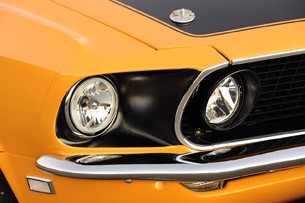
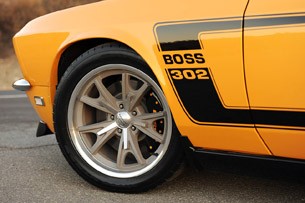
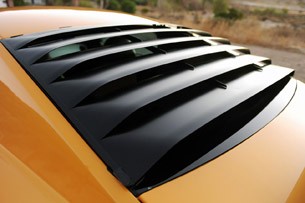
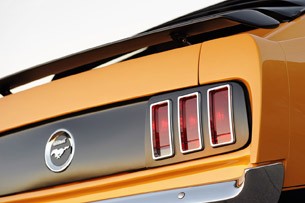
The front hood and quarter panels are replaced with fiberglass reproductions, sized to the dimensions of the slightly larger chassis (the '13 Mustang is about 13.5 inches longer and four inches wider than a '69 Mustang). The Ford's original steel door skins, steel roof and steel rear decklid remain in place, but fiberglass skins are placed over them to give the body a proper retro-styled figure.
Basic muscle-car stature in place, the period-look front and rear fascias are added. A new hand-crafted grille, aluminum brightwork and chrome bumpers, all looking as if they are straight out of the '60s (yet each custom-made for Retrobuilt) are bolted in place. The reproduction chromed steel bumpers, like the other parts, are slightly wider to fit the modern vehicle's dimensions. The details are impressive, as the reproduction mirrors, chrome door handles and other badging are all painstakingly period-correct. The hood pins are redundant (the OEM latching is retained), yet they are fully functional after the primary and secondary latches are released.The reproduction mirrors, chrome door handles and other badging are all painstakingly period-correct.
The stock engine, a naturally aspirated Coyote 5.0-liter V8 rated at 420 horsepower, is retained and customers are offered a choice between a six-speed manual gearbox and a traditional torque-converter six-speed automatic transmission (most choose the manual, but our test car was fitted with the slushbox). The hood scoop is functional, engineered to supplement the factory airbox with a fresh blast of outside air courtesy of a custom "Y-pipe" in the engine bay. An aftermarket exhaust, manufactured by MagnaFlow, is bolted in place after the catalytic converters, thus retaining all emissions equipment.
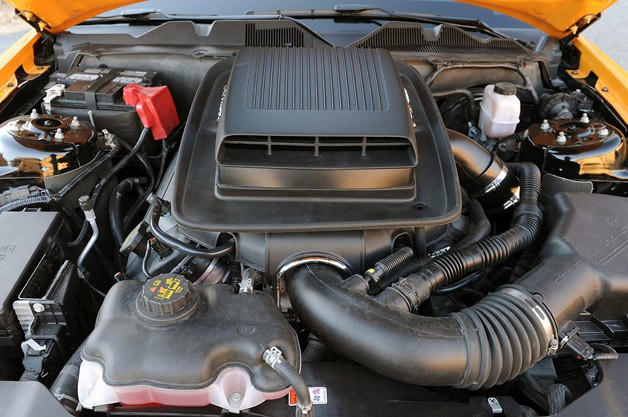
Springs and sway bars are replaced with an Eibach Pro-Plus suspension kit before one-piece aluminum alloy 18-inch American Racing wheels are bolted to all four corners (machined to look as if they have hub spinners from a distance). The wheels are wrapped in Nitto NT 555 Extreme ZR summer performance tires with a treadwear rating of 300. The brakes, single-piston sliding calipers over ventilated disc rotors, are left stock (our test car had alloy covers over the hardware to make them appear... well, upgraded).
Bodywork and painting is all done at the Retrobuilt facility. After the customer's choice of color is applied, a final clearcoat goes over the graphics. (The trademarked 'Boss 302' graphics on our test car were added by the owners, as the company doesn't want to get itself into hot water with Ford.) Finally, after a six-week wait, the vehicle is delivered to the customer.Providing late-model comfort and reliability is the object here, not a 1960s-era interior.
Pressing the retro-cool thumb button on the door handle may set up those drooling over the exterior for disappointment, as the interior is left completely bone stock – there isn't even a Retrobuilt badge on the dashboard – exactly as it left Ford's factory. Then again, providing late-model comfort and reliability is the object here, not a 1960s-era interior.
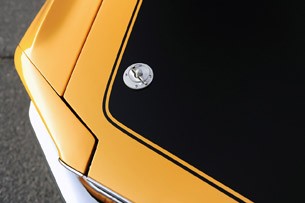
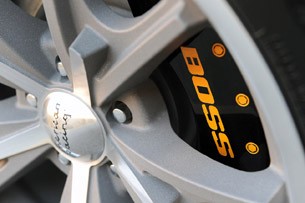
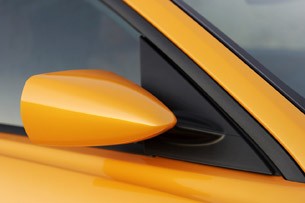
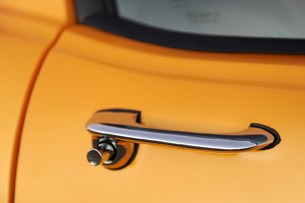
We spent a few hours with the 1969 Fastback just north of Los Angeles in our own backyard. All visual cues aside, the coupe is basically a rebodied 2013 Mustang with an aftermarket suspension and exhaust. We expected it to drive like any lightly modified late-model Pony Car – as we would discover, that was mostly the case.
Settled into the familiar cabin, we ignited the V8 and it roared to life. The MagnaFlow exhaust really opens up the engine's lungs, and the exhaust settled down to a very throaty idle. Outward visibility is challenged, especially with the aluminum slat louvers on the rear window, but the vehicle retains its parking sensors, so low speed maneuvering isn't too difficult.The MagnaFlow exhaust really opens up the engine's lungs, and the exhaust settles down to a very throaty idle.
Despite its 40-year-old appearance, the Retrobuilt Fastback is every bit as comfortable as its donor was (that shouldn't come as any surprise). Everyone within the cabin will enjoy modern climate systems, satellite-based navigation and iPod-integrated infotainment. The seats are comfortable, the dashboard illumination is bright and crystal clear and there are plenty of cup holders. The stock Mustang is nice, so we had nary a complaint in this area.
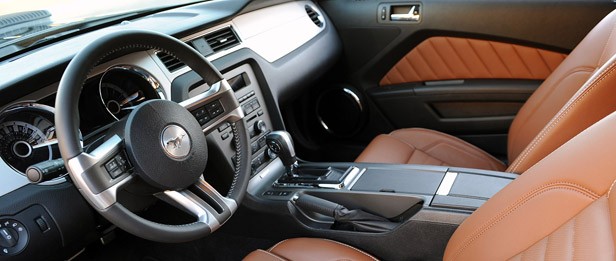
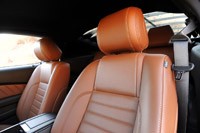
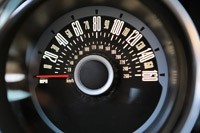
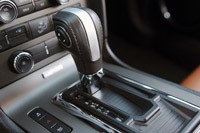
Thanks to the burly 5.0-liter, the 3,600-pound two-door has plenty of thrust. While the original 1969 Mach 1 would sprint to 60 mph in about 5.7 seconds, the Retrobuilt version will break the same benchmark in about 4.3 seconds and handily outrun its spiritual predecessor in a race to any distance. The brakes are every bit as strong as the engine, hauling the proceedings down from speed with confidence repeatedly. The modern technology is damn good - the original classic wouldn't stand a chance against the Retrobuilt in any performance category.
We thoroughly enjoyed piloting the two-door along familiar routes, comfortably tooling through the canyons above the deep blue Pacific Ocean in the metallic yellow Fastback, It was nice to peer over the classic hood, taking in the nostalgic aura free of loose steering, hot cabins and unsupportive seats. However, it was not all bliss as we did discover a few flaws along the way. Unfortunately, both were related to the mechanical tweaks done during the transformation back in Missouri.The Retrobuilt version will handily outrun its spiritual predecessor in a race to any distance.
Even though the upgraded sway bars eliminated much of the unnecessary body roll, the Eibach spring setup seemed completely wrong (spring rate too low?). Damping was good, but the coils were soft and ineffective. The roads we traveled had some soft dips that caused the Fastback to bottom-out more than once during our spirited drive (upon mentioning this to Retrobuilt, the team said they would look at the spring issue immediately).
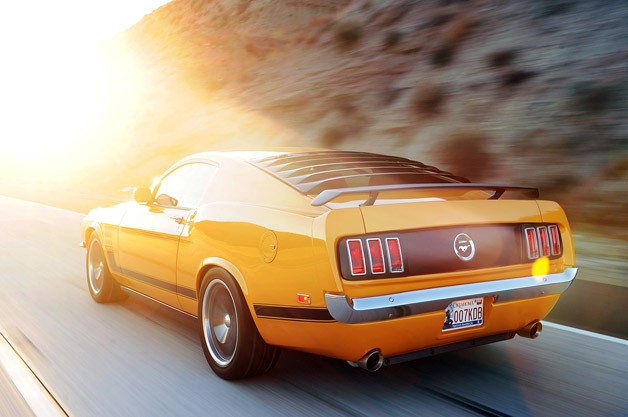
Owners with the six-speed manual gearbox may never observe it, but we also noted an odd relationship between the low-resistance MagnaFlow exhaust and Ford's electronically controlled six-speed automatic transmission. In an effort to optimize fuel economy, today's slushboxes are programmed to shift up to the tallest gear as soon as possible, While this is great for EPA figures, it meant the V8 was spending nearly all of its time just below 2,000 rpm. At this speed, the exhaust boomed annoyingly through the cabin. We played with the gears in manual mode and found the only way to avoid the concussion was to downshift and keep the engine spinning a bit faster (about 3,000 rpm). We have to imagine that this isn't a problem for those rowing their own gearboxes as they would never lug the engine this way – it just may be a moot point.
Those easily solvable concerns aside, Retrobuilt's 1969 Fastback is one slick, no-compromise muscle car. Its fit and finish appeared top-notch, and everything on the vehicle passed close scrutiny (especially to the countless onlookers in the parking lot who were magnetically drawn to the Fastback when we stopped to chat). In terms of pricing, the full Retrobuilt treatment costs about $30,000 above and beyond the price of the donor vehicle – a figure much easier to swallow if you consider the work involved.Everything on the vehicle seemed to pass close scrutiny.
While we drove a converted Mustang GT with an automatic, our choice would be to raise the entertainment quotent by handing Retrobuilt a factory-fresh Boss 302 with a six-speed manual gearbox. Our instructions would be to leave the suspension and exhaust stock, yet put some R-compound rubber on period-correct Magnum 500 wheels to really drive the message home. Lastly, we'd opt for full Boss graphics over Candy Apple Red paint – as if there were any other way.
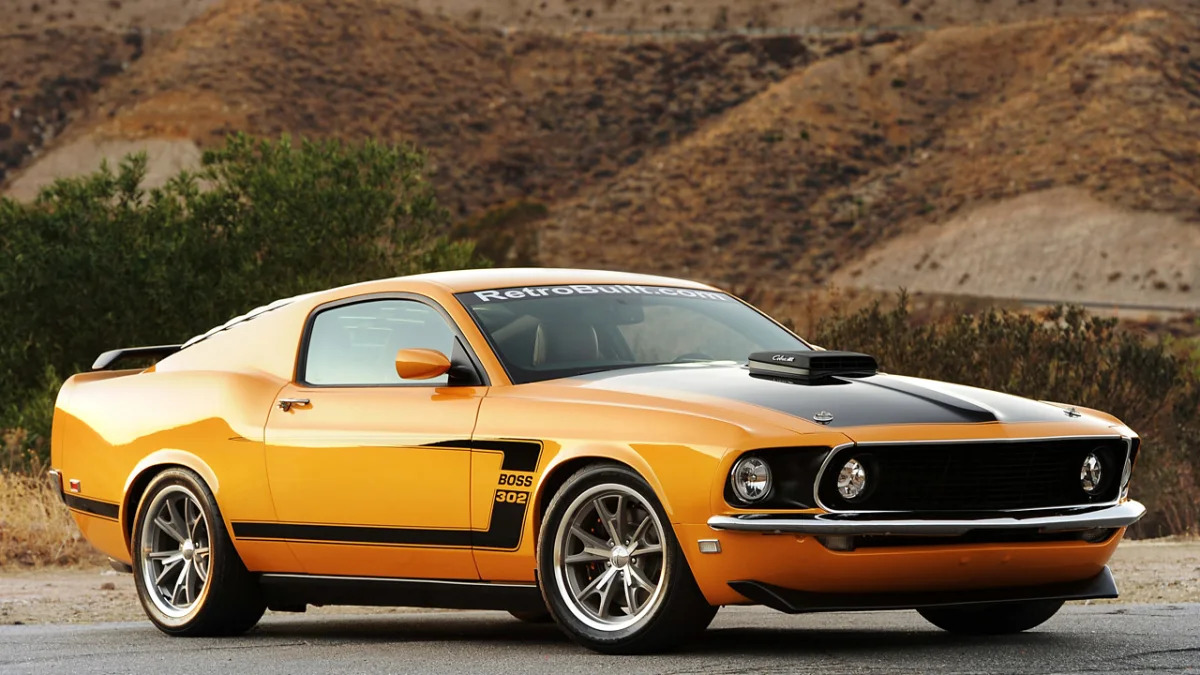









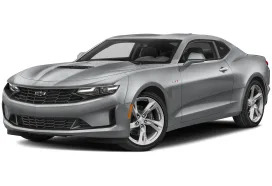
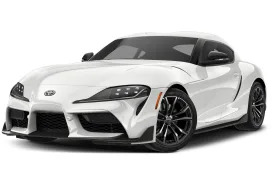

Sign in to post
Please sign in to leave a comment.
Continue